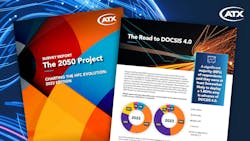Broadband access and media distribution technology specialist ATX Networks today announced the latest results of its 2050 Project Survey, a primary research project conducted by the company that charts the long-term evolution of hybrid fiber-coaxial (HFC) networks. ATX says the research is intended to provide cable MSOs with insights into what their peers are planning when it comes to future technology upgrades, and other issues impacting their competitive standing over the next several decades.
According to an ATX press relase, now in its third year, the 2023 edition of the survey uncovers increased support for the Extended Spectrum DOCSIS (ESD) version of DOCSIS 4.0. Further, ATX said the latest iteration of the survey also shows an uptick in confidence that the multigigabit-per-second speed and capacity enabled by the newest DOCSIS specifications will provide more than enough capacity for MSOs to fend off encroaching fiber-to-the-home (FTTH) providers the as preeminent suppliers of broadband connectivity well into the future.
The 2023 edition of the ATX 2050 Project Survey draws on the opinions of nearly 100 cable professionals from roughly 60 organizations, the majority of which are located in North America. The company said this year’s findings in particular underscore the desire of MSOs to minimize regrettable spend by extending the life of existing HFC investments and avoiding unnecessary operational expenditures.
ATX said the survey's findings indicate that MSOs increasingly recognize that upgrading, rather than overbuilding their networks with fiber, gives them a significant advantage over competitors in terms of cost, time to market and minimizing customer disruptions.
Survey drill-down
According to ATX Networks, almost half (48%) of all survey respondents said they will activate DOCSIS 4.0 technology in their HFC networks before the end of 2025. Nearly 65% of cable industry professionals now say their companies will install DOCSIS 4.0-capable equipment as soon as it is available.
Almost 60% of respondents estimated that the bandwidth enabled by a high-split architecture will keep MSOs competitive for no longer than the next five years. Only 20% of participants said they consider FTTH providers to be a significant long-term competitive threat, down from 27% in 2022.
ATX said that nearly 80% of survey takers identified modernizing lead-acid battery standby power operations as a priority in the coming year. Meanwhile, in 2023 the percentage of cable professionals who estimate that it will take them 20 years or longer to completely replace their HFC networks increased by 8%
Other topics covered in the ATX 2050 project survey include adoption rates for Distributed Access Architecture (DAA) technologies, requirements for additional intelligence and telemetry capabilities in HFC actives, and the methodologies MSOs are using to convert their coaxial plants to PON technology.
ATX CTO Jay Lee remarked:
“At a time when fiber is often leading the conversation, our 2050 Project celebrates the HFC network and the long-term evolution of the outside plant. Each year, the survey paints a vivid picture of where the HFC network is headed and the prevailing attitudes of cable professionals as they approach dozens of critical architectural, technology and business decisions. We open survey findings to the entire cable industry to further promote a cooperative spirit that has been the hallmark of this community since its inception.”
In addition to its 2050 Project Survey, ATX noted that it regularly consults with its Customer Advisory Board (CAB) to gain insight into the future direction of the cable industry. The ATX CAB, which last convened in late February, includes senior executives from a diverse cross-section of the cable industry, representing operators of multiple sizes and from regions throughout North America, CALA and the rest of the world. ATX added that its CAB explores challenges and alternative approaches to pressing business issues, offering guidance on ongoing and future ATX product development to ensure solutions are optimized to meet the future requirements of the HFC network and beyond.
Pao Lo, VP of network engineering at Midco and an ATX CAB member, commented:
“Regular interactions among MSOs and annual insight into HFC evolution trends help to guide the efforts of engineers and others building out future broadband networks. Midco commends ATX for its efforts to provide a forum for an open exchange of ideas and expertise.”
ATX outside plant experts will be providing analysis of the survey results during an ATX-hosted webinar on Thursday, April 27, at 11 AM EDT. Register for the webinar.
